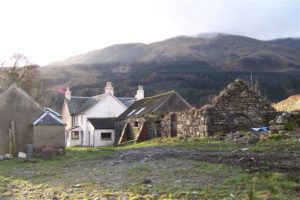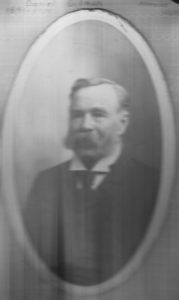The Bonner Family came from Scotland, driven from there in the 1820s during what the English politely call the “Clearances,” which comprised of driving families off their farmland, so it could be used for the more profitable sheep grazing. Families were driven from the Scottish Highlands (north country) to coastal areas, where life was much harsher. Some were forcibly sent to the New World, and others voluntarily crossed the ocean in search of a better life.
Families tended to be large and available farmland could not be divided up among all the children, increasing the pressure on many to emigrate. Infant and child mortality was high, relative to modern times, and parents were under great economic pressure to provide for themselves, their children, and the children of their children. Canada and America offered vast expanses of uninhabited—virgin land for farming.

The first Bonners on record were James Bonner (1807-1893) and Jane Bonner (1810-?). The couple was married in Kirkcolm, Wigtownshire, Scotland on 22 Nov 1829, and emigrated to Canada soon afterwards. Their first son, the next in our line, John Bonner (1832-1908) was born in Lachine, Quebec. John married Nancy Turnbull (1837-1925) in Ontario in 1856. John and Nancy had 4 children, including R. J. Bonner, father of Gordon Willson Bonner.
The Bonner Family—Turnbull Branch
The story of the Turnbull branch of the Bonner family is rooted near Newcastle-upon-Tyne, in Northumberland County—the northeasternmost county of England, on the Scottish border, and in a little town just over the border—Lilliesleaf, Scotland.
The Turnbull ancestors were landed gentry, the Bates family, which owned a large estate known as Milbourne Hall in Newcastle-upon-Tyne. Ralph Bates (1730-1783), a baronet, was descended from several of the local noble families, including the Chaytor and Tempest families—through whom the Bonners are direct descendants of several prominent ancients, including King Alfred the Great, Charlemagne, and Saint Arnulf of Metz.
Ralph Bate’s wife, Ann Ellison (1734-?), was the daughter of Henry Ellison (1699-1775), also a baronet. The Bates family was related (by marriage) to Sir Cuthbert Shafto (1736-1812), yet another Northumberland baronet, who is mentioned in Brant Bonner’s letter about the Milbourne estate.
Several of these individuals served as High Sheriff of Northumberland at various times, including Ralph Bates (1762), his son and Nancy’s brother, Ralph Bates (1812), Annie Ellison’s father, Henry Ellison (1734), and Sir Cuthbert Shafto (1795).
Ralph and Ann’s daughter Nancy married a commoner, Robert Turnbull (1776-?), a non-commissioned officer in the British Army and a tailor, for which marriage Nancy’s parents disowned her. As a youngster, Robert’s son Robert Jr (1808-1883) returned to Millbourne Hall to try to reconnect with his grandparents, Ralph and Ann Bates, but was turned away. Read about this episode in A Proud Scot Declines a Sovereign and a Meal. Robert Jr emigrated to Canada in 1835, where he had a tailor shop in Galt for many years.
The Willson Family—McKinlay Branch
The Willson family probably emigrated from Scotland in the 1700s. The first Willson whom we have documentary information is Benjamin Willson (his father might have been the John Willson who arrived in New Jersey in 1718), who was born and raised in Wantage Township, Sussex County, New Jersey. He first appears in land deeds in 1763 in Wantage, New Jersey. He was a farmer and a Quaker, and was a British Loyalist during the Revolutionary War. As a result, as happened to many Loyalists after the war, life became untenable for him and his family in the U.S. after the war. They moved to Canada in 1787.

Photo by Kathryn Parchelo
Annie Willson’s maternal grandfather, Duncan McKinlay, was born and raised on the McKinlay family farm called, “The Anie” (Scottish for “ford of the deer”), in the parish of Callander, Perthshire, Scotland. The first owner of this farm of record was Finlay McKinlay, who lived and farmed there in the early 1600s. He had a grandson, John McKinlay (born about 1645), who in turn had 3 children:
- Donald McKinlay (born 1669)
- James “The Trooper” McKinlay, who went to Ireland, then America, and is a direct ancestor of President William McKinley
- Our ancestor, John McKinlay (born 1679)
Many generations of McKinlays lived and farmed the “Anie,” starting with Finlay McKinlay in the 1600s. Some of the original structure still stands. We have some information about Annie Willson’s maternal grandfather Duncan McKinlay (1799-1882), who married Elenora Cameron (1768-1859). James was a “tacksman,” who held intermediate status in Scotland. Tacksmen generally rented rather than owning their land, but often rented from a relative, and subleased some of the land to others. St. Bride’s Chapel, near the Anie, is where James McKinlay was buried in 1825. His headstone still is visible.
James and Elenora McKinlay had 9 children. Annie Willson’s father (their fourth child), Duncan, immigrated to Canada with his brother, Ewen McKinlay. The reason(s) that Duncan and Ewen left Scotland are unknown. However, the family farm would typically pass to the oldest child and farmland was scarce in Scotland for those looking for new land. Further, the 1820s and 1830s were a time of economic distress, in addition to the cruel English “clearances” that put further pressure on farmland. It seems a safe assumption that the reason for their emigration was economic.

abt 1875
Duncan McKinlay married Anne Leslie McLean (1815-?) in Kent, Ontario in 1839. Their daughter Catherine McKinlay (1846-1923) married Daniel Gilman Willson (1841-1909) in Kent in 1869. Their first child was Annie Willson
